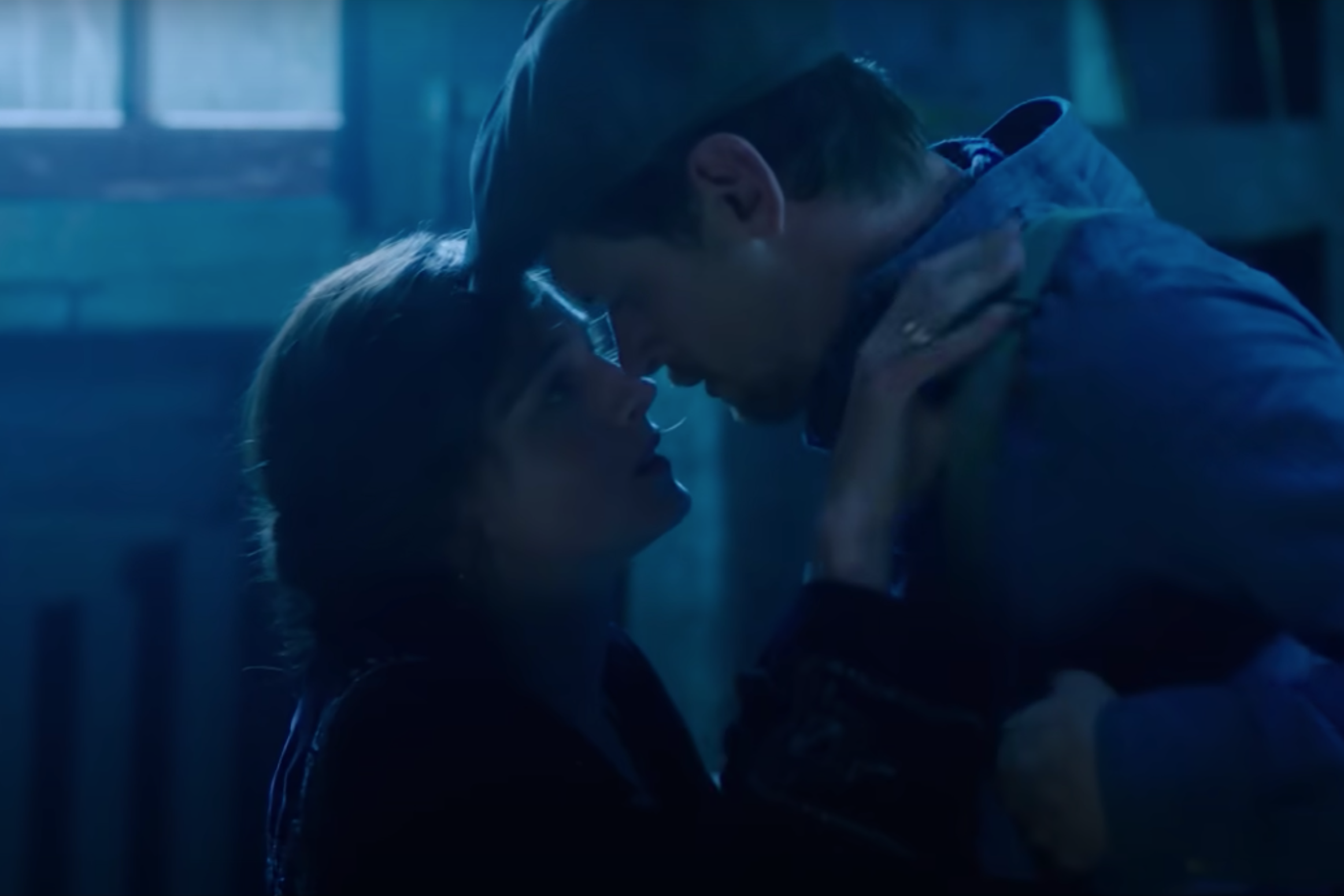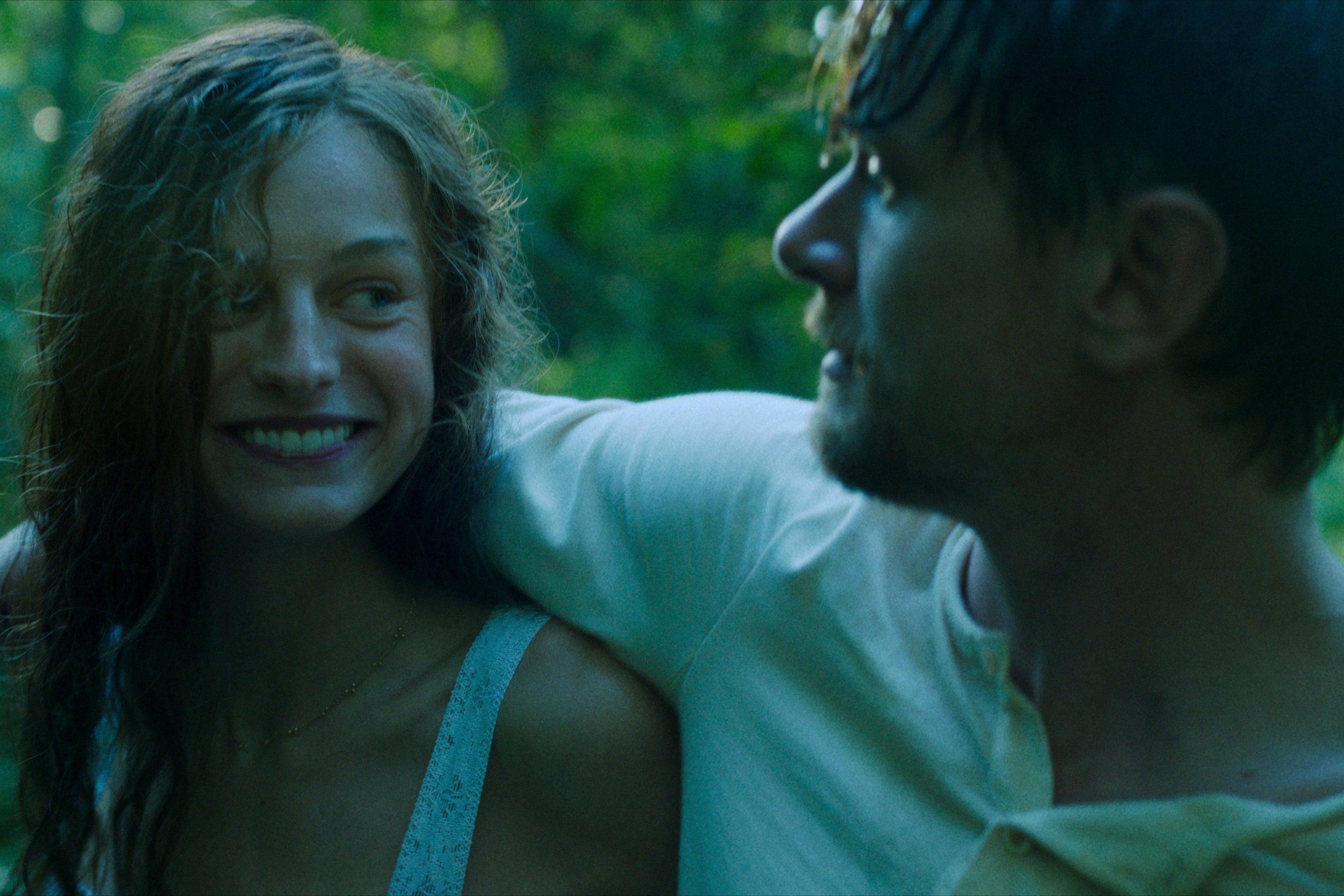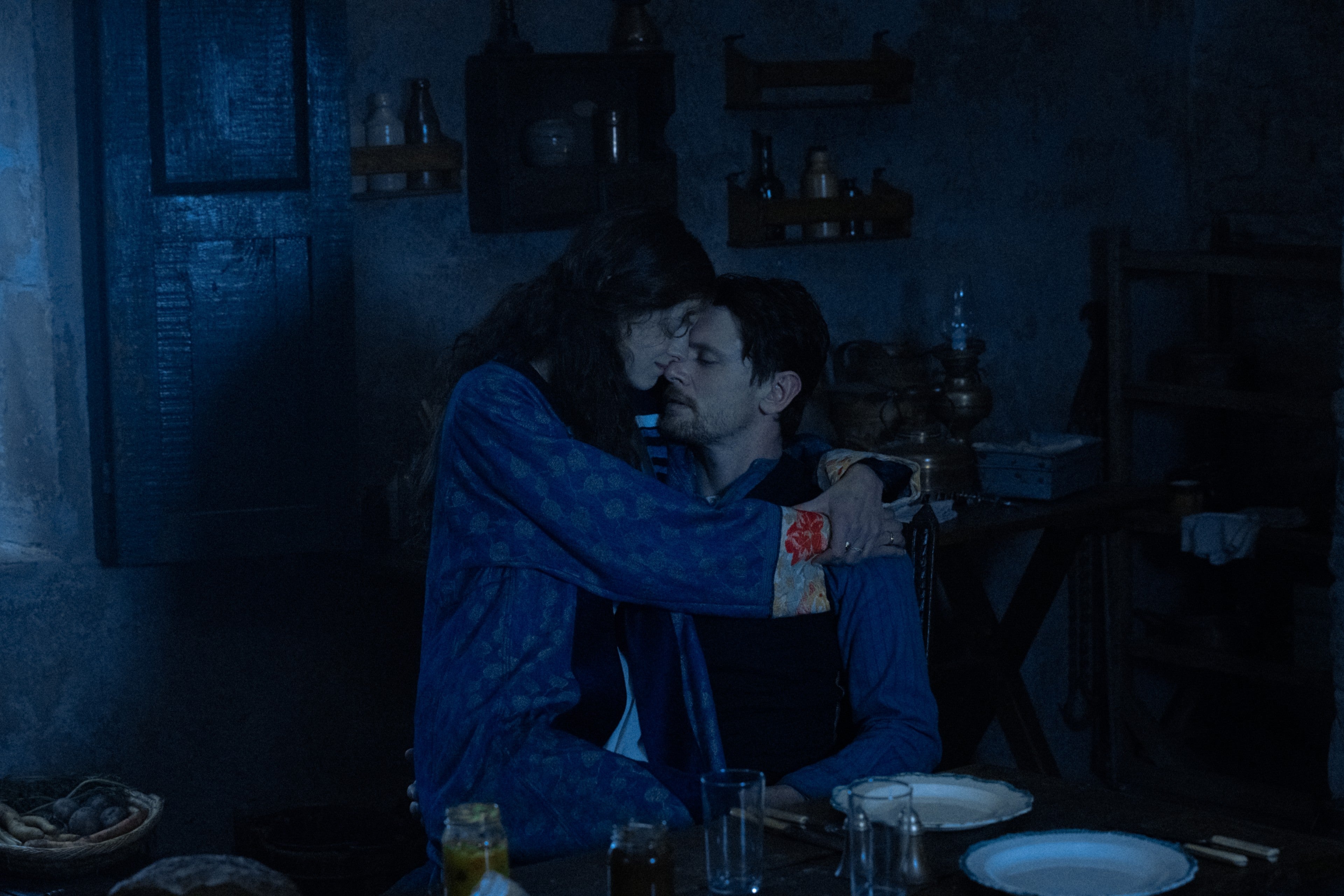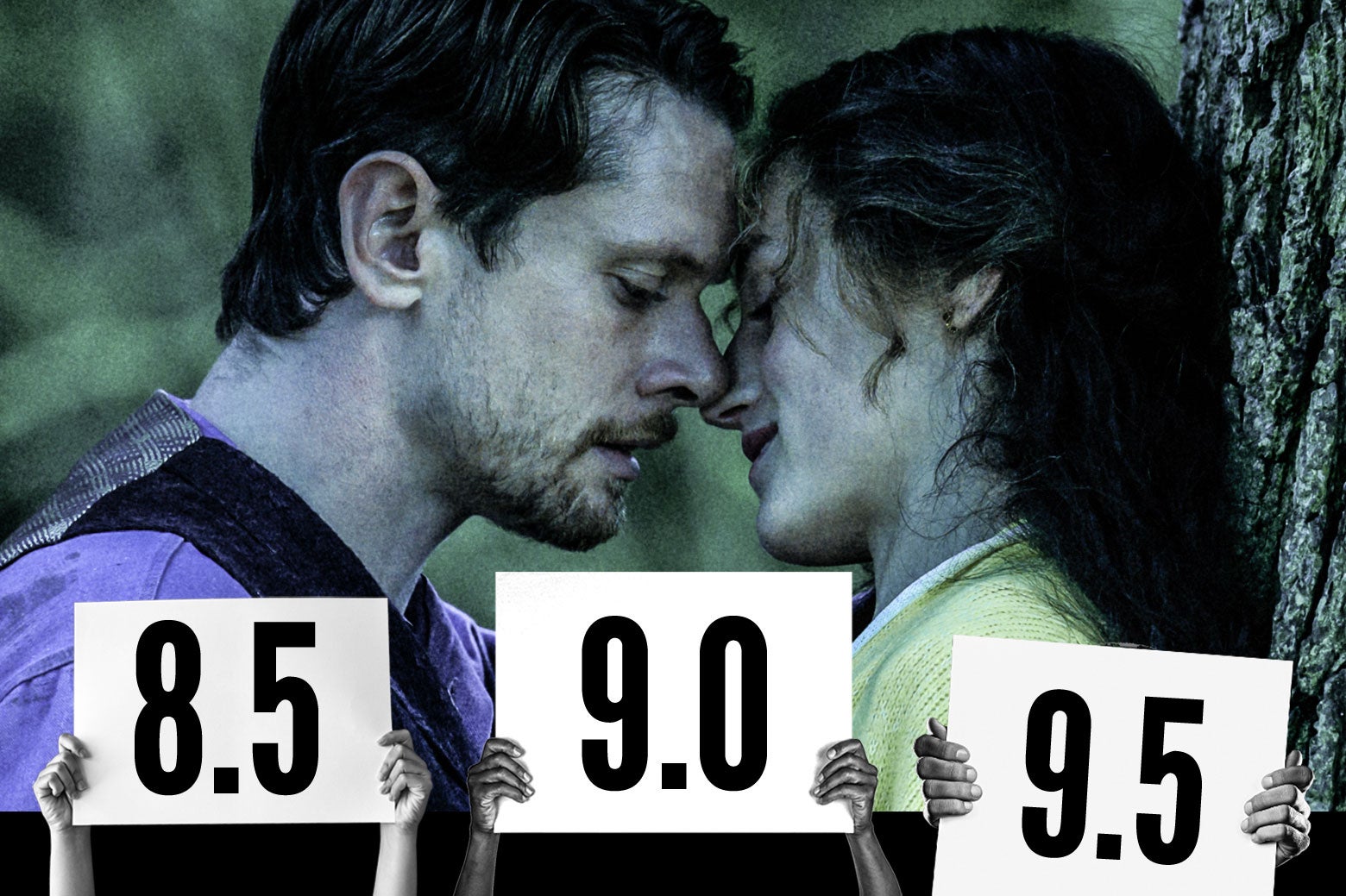In Sex Reviews, writers offer a sober critical assessment of the sex scenes in new releases.
Lady Chatterley’s Lover, the latest version of D.H. Lawrence’s notorious long-banned 1928 novel of the same name, debuts on Netflix on Friday. Director Laure de Clermont-Tonnerre’s film adaptation of the erotic classic stars Emma Corrin as Constance Chatterley, the free-thinking English daughter-of-an-artist who marries an aristocrat who goes off to war and comes back paralyzed, and Jack O’Connell as Oliver Mellors, also a veteran, a working-class man from the village on the Chatterleys’ estate, who is working as their gamekeeper. Connie and Oliver are each painfully lonely for different reasons, but when they come together, they discover that the answer to the question “Will I ever find someone who reads the same books I do, and has sex in a way that I like?” is “yes, yes … YES!”
Below, we—Slate senior editor Rebecca Onion, who likes to watch movies with kissing in them, and Claire Jarvis, a critic who used to study Victorian and modernist literature—judge whether these sex scenes are any good.
The First Time, With Chicks (at 45:06)

Rebecca: This initial encounter kicks off when Connie—who is absolutely miserable, stuck in her giant house with her husband, worrying that not only will he never be physically able to have sex with her again but also that he’s kind of a jerk—takes one of her long daily walks around the estate and goes back to the hut where Oliver is raising pheasant chicks. She tries to hold one of the chicks in her hands, but can’t catch it, so Oliver comes around behind her and shows her how to cup the chick. “You’re trembling more than he is,” he says, and then Connie starts to cry. He stands her up, concerned, and she hugs him. I thought their first hug, where he holds his hands awkwardly at his sides, was pretty sweet. Then she kisses his hand, and he finally comes around to kiss her, and then … it’s missionary style, on the floor. Wham! What did you think of the way they staged this?
Claire: Well, first of all, it’s not technically the first sex scene in the film, which I think is important to note. The first scene is with Clifford Chatterley just before he is sent back to the front where he suffers a debilitating spinal injury (this sets up the “Clifford can’t satisfy Connie” plot). That sex scene is interesting because it veers away just as they start to fumble with their clothes, in the style of a PG movie. Then the second sex scene is a scene in which we see Connie masturbate, relatively graphically, on a couch. So, by the time we get to this scene, which is Connie’s first sex scene with Oliver, we know that Connie is unsatisfied, and may have always been unsatisfied by Clifford, even before he was injured.
I also want to flag that the film leaves out the few affairs Connie has with Clifford’s friends before Oliver, in the book—this is telegraphed slightly in the film but seems to be kept a flirtation, not an affair, with Michaelis, the Irish playwright. What’s interesting about this choice is, first, that it keeps Connie’s virtue a bit more intact—she’s hot for Oliver, not just anyone!—and, second, it maintains a very clear class throughline—in the novel, Michaelis is also lower class, like Oliver, but he is perceived as reasonable as an object of desire because he is an artist, not a “servant.”
Finally, I think it’s important to note that, in the novel, Lawrence writes a lot about the horror that is frictional sex (this is a particular Lawrentian bugbear—he really doesn’t like the idea that women would use friction to climax, preferring a vision of a deeply enveloping vaginal, not clitoral, orgasm). As we shall see, this is not such a major theme in the Netflix film.
OK, so as for the actual sex scene—yes, the tiny chick in the hand! This is sort of classic Lawrence, I think: Sex is something where vulnerability and intensity leads to a kind of short-circuiting of moral life, and the resulting bliss ends up producing a new, higher order of morality. ALSO, the chick clearly stands in as a visual metaphor for the child Connie cannot yet have, and that makes it both tender and a little depressing to me.
In the Hut, Interruptus (at 54:00)

Rebecca: Totally good points you’ve made about A) the two previous actual sex scenes in the movie and B) the book’s elevation of vaginal over clitoral orgasms.
Regarding A): It tells you something basic about my viewerly response to the Connie-Oliver scenes (I liked these actors, and thought they had good chemistry) that I thought of “sex in this movie” as being only “Connie-Oliver sex.” Busted!
Regarding B): Your good point about sex in the book (was this novel, which I first read in high school, where I got my original bad ideas about female orgasm?) makes this second scene between Connie and Oliver even more difficult to parse.
She goes back to the hut, on what I think is the next day after their first encounter, and waits impatiently for him to show up. When he does, they kiss, and she keeps saying “We don’t have much time.” They go into the hut and she sits on a table, and he stands between her legs. First, he wets his finger and puts it between her legs. Second, he starts to administer cunnilingus. (Dear god, how awkward that sounds!—but how else to say it?) But—she’s not into it? She keeps looking out the window, impatient and worried, and eventually, in the middle of the encounter, she says, “I have to go,” and leaves.
What did you make of this scene, which did not, I think, take place in the novel? It felt like the filmmakers wanted to make Oliver 60 percent more of a modern lover. In the novel, he’s got all kinds of theories about women being certain ways during sex—theories that include, as you said, a dislike of women who like their clitorises rubbed. And the novel’s Oliver also—I should mention—doesn’t like to do what I think Lawrence calls “mouth kissing.” In this movie, he’s kissing, he’s licking, he’s doing the thing! But it’s not what she wants.
Claire: Absolutely agree they wanted to make Mellors a modern lover—one corrective the film carries out is calling him “Oliver” and not “Mellors,” like Lawrence did in the novel, a move that reinforces the equality between the lovers. A couple of things: Oral sex is really downgraded in Lawrence, I want to say because of his deep commitment to a confluence of eroticism and pregnancy. (Interesting, especially since Lawrence himself had no children, though his wife Frieda did with her first husband!) I think you see this as a kind of extension of a pretty normative Victorian marriage plot: You know a marriage is wrong if there are no children! And unlike in a modern telling of this story, I don’t think Lawrence’s novel presents Connie as “longing to be a mother” but rather suggests that good sex produces maternity—for him, again, a child is a sign that the sexual connection is working.
Something else you said above, which I really want to flag, is that Lawrence has been scuppered critically for the past few decades. I think a big reason for that is not, surprisingly, his nationalism or casual racism, but because he thinks vaginal orgasm is a good thing. I am joking a little bit, but I think a lot of the feminist critique of Lawrence comes down to a sense that his vision for sexually fulfilling womanhood must be vaginal and not clitoral. I mean, I don’t know if I would say this is a bad idea about female orgasm broadly, but it is certainly a limiting one. So, I think the oral sex in this scene might be a strange choice, if we want to think strictly about the movie’s fidelity to its source material, since it’s frictional and one-sided, two things he complains about a lot. Also missing in this version is a real reckoning of Mellors’ problem with his wife, which is that she was too frictional in sex! Curious!
In the Clearing, in the Woods (at 1:02:00)

Rebecca: This is probably the hottest and best sex scene in the movie. The two lovers bump into one another at a farm on the estate and then find one another on the path. They don’t have time to go to the hut, so they go into the woods—where we find out, because she tells him so, that Connie wants Oliver to “fuck” her. “You would want coarser treatment with me,” he guesses, which I suppose is Oliver sort of realizing what the problem was with his last approach, but also, kind of a little moment of class commentary, interesting in a movie that does away with a LOT of the class stuff in the novel.
The music gets really intense here, kind of building to a crescendo, which helps with the vibes. They lie on the ground, on his coat, and … they, indeed, fuck. First missionary, then he kind of kneels on the ground and she straddles him. There is a lovely background of ferns and leaves. They seem to have orgasms at the same time, and her eyes get really unfocused and sort of stare around the woods, which is movie stand-in for the pages and pages in the novel in which Lawrence describes the straight-up epiphany Connie has after this particular climax.
In another line taken straight from the novel, Oliver says, “We both came off together that time. It’s good when that happens. Some people live their whole lives and never know that feeling.” In the book, this is Mellors’ requirement of sex, as I recall—MUTUAL ORGASM—which was another thing that gave me really unrealistic expectations as a teenager.
Claire: OK, this is REALLY important as a connector to the novel, because this is the infamous scene where Connie and Mellors name their genitals and put flowers on them in a little wedding scene. And the film LEAVES THIS OUT. That was a good choice, because yammering on about “Lady Jane” and “John Thomas” is, in 2022, embarrassing. What is less embarrassing is naked frolicking outdoors, which this movie has in spades. For my money, this scene is less evocative than the Nude Childlike Blissful Running in the Rain later on, but I think the lushness of the green around them is very good. Also, you noted Corrin’s eyes, which, in my view, are one of the strangest, best things about the film. Their pupils are so dilated! It’s wild!
I think I disagree that the movie gets rid of the class critique. I mean, it is only 2 hours long! I think it’s often easy to think Lawrence’s book was banned because of the sex scenes, but the real reason—I think—was because it showed a mutually fulfilling relationship between the gentry and the servant class. I mean, Mellors is not presented as a lug at all—he’s sensitive and reads the same books as Connie. I also appreciate that they kept Connie’s lightly Bohemian upbringing present in the film (her father is a famous painter, and there’s a great scene with him being very matter-of-fact about sex—how surprising for an early 20th century dad!).
You’re right about the novel’s attitude toward simultaneous orgasm. Again, Lawrence is definitely criticized now for having very unrealistic expectations about specific transcendent aspects of sex, but I think the film helps show how the ideal he holds up can be imagined as an ideal of, if not equality, then equal footing. Lawrence’s views about sexuality seem rigid to us now, but in Lady Chatterley we are able to see the way that the pairing of Mellors and Connie is supposed to be one built on shared commitments—to sex, to reproduction, to greater political fairness.
In the Cottage, at Night (at 1:37:00)

Rebecca: The last sex scene in the movie takes place in Oliver’s cottage, the night before Connie is due to go to Venice, where she’s traveling with her family. She has told her husband that this will be the trip where she will find someone to impregnate her—something her husband, who still doesn’t know about her affair, has said he wants, so long as the man involved is “the right sort.” (He doesn’t mean a gamekeeper.) The two lovers are anticipating their separation, and are emotionally raw after Oliver has met Connie’s sister Hilda, who, despite being open-minded enough to keep Connie’s secret and help her accomplish this tryst, is not a fan of the relationship.
Is this encounter—which is filmed in blue darkness, in stark contrast to the daylight forest hues of the other sex scenes—a doggy-style, from-behind, P in V scene? That’s how it looks on screen. But in the book, isn’t this the scene where Oliver and Connie have anal sex? Did this movie chicken out on Lawrence’s most “obscene” sequence?
Claire: I mean, yes. It does. The critic Leo Bersani famously called Lawrence’s view of anality “melodramatic,” and the descriptions in the novel are deeply explicit. First, there’s Lawrence’s endless repetition of the concept of the “root” (anus) as a source of shame. When Mellors sodomizes Connie in the book, the experience forces shame from her, and works as a sign of the pair’s utter expulsion of the social world from their romance. That’s a lot to hang on a sex act, I know, but it’s key to Lawrence’s views about sex’s basic intimacy, and it’s also the key to the book’s early censorship as pornography.
It’s interesting that the film is so explicit about genitals, which I count as a good thing, but shies away from making the content of this scene so explicit. It’s to the credit of the central actors that they both revel in embodiment—again, I am thinking of the rain-dancing scene—because I think it shows just how revolutionary Lawrence’s work was. These are pretty buttoned-up people, and showing them, nude, in a kind of child-like abandonment in the rain, is pretty visually arresting. But that makes this final scene a bit stranger: Why not make the anal sex really explicit? I’m not sure how you would, especially because it’s hard to film these kinds of scenes outside of pornography, but it does seem like a strange choice.
Overall Ratings
Rebecca: I’d give it a 7 out of 10. Really good kissing, good chemistry. If I’d never read the novel, I wouldn’t miss the anal.
Claire: I think it’s an 8 out of 10 for me. It’s not the most explicit sex that Netflix has produced, but I think the commitment to the nudity on the part of the actors, and then close, carefully shot sex scenes themselves have a fragile intimacy that works well with the source material. They should have figured out how to make the anal sex scene clearer, though I’m glad they didn’t talk a lot about “roots.”
